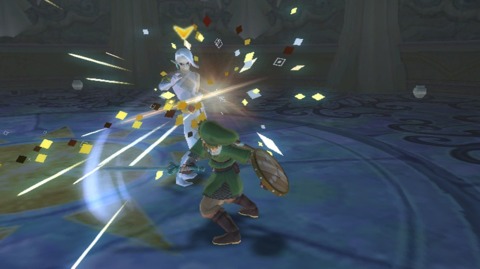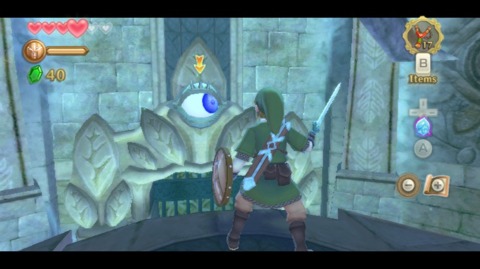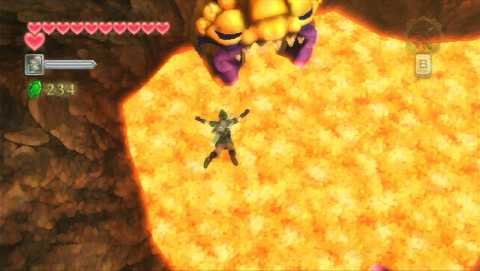
The Legend of Zelda: Skyward Sword is Nintendo’s closing argument on motion controls with Wii, especially as it relates to traditional games. It seems fitting that saving the world alongside Link will, for many of us, act as the first and last time we spend dozens of hours with a game inside our Wiis.
And boy, how far we’ve come. It takes only minutes with Twilight Princess again to understand how tacked on those motion mechanics were, and Skyward Sword’s evolutionary leaps only compound the idea that we should have played Link’s last adventure with a GameCube controller in both hands. How you come into Skyward Sword partially depends on how you took to Link the last time. Top to bottom, I found Twilight Princess painfully boring, which is, perhaps, a fate worse than bad. My reaction was fueled by a combined indifference to the game’s uninspiring world, characters, and gadgets, and the tepid, half-hearted implementation of motion to make the mechanics more physical.
Especially as it relates to the last point, Skyward Sword could not be more different. It’s not just the added fidelity from Motion Plus that makes the difference, it’s that your physical actions are truly meaningful when it comes to engaging in just about every combat scenario in Skyward Sword. The very first enemies in the game will beat your ass to the ground if you’re not reading their moves, and Skyward Sword quickly teaches players that “waggle” will not work here--period. To be successful in combat, reacting to the placement of each enemy’s hands is of utmost importance, and while one becomes extremely adept at taking out the early combatants after a few hours, from start to finish, Skyward Sword asks much of your wrist. When the credits rolled, my hand ached, and it felt great.
Combat never becomes difficult, but remains challenging, as you’re constantly tasked with reacting to enemy actions (i.e. placing their sword to the left) with your own (i.e. slashing your sword to the right). Early on, the enemies are very blatant about showing weaknesses. That's less true later, forcing you to spend several failed encounters sussing out various “tells." In one case, a lizard appears to be hiding its weak arm on the left, when in reality you must swing around from the right--a sleight of hand. Furthermore, for him to even show off that weak point, you must swing away a few times and force him into a defensive posture. The most satisfying encounters are when enemies swap tells over and over, asking players to be extraordinarily quick with a response, and this becomes more demanding over time. The game is always reading your sword in relation to the enemy, and if you telegraph an attack, enemies will smack back.

Link’s sword is front and center here, with only a few of the gadgets playing into combat. Mastery of the sword is of utmost importance. It’s strange to spend so much time talking on and on about combat in a Zelda game, but it’s no longer about smashing on the attack button anymore. Quite literally, you are part of combat, and motion controls, done well, provides a satisfaction that wouldn’t be possible any other way. This is the finest example yet.
One facet of modern games Nintendo’s dodged is overcomplicated design, focusing on a simplicity that appeals to a larger audience. The Zelda series has always been described as an “action RPG,” but in light of what the RPG has become with games of immense depth like The Elder Scrolls V: Skyrim, Zelda has become more RPG lite. And that’s fine! Nintendo can contently stay in its corner, while Bethesda tackles another. But Skyward Sword takes steps to address the gap and falls short. The game includes a forgettable element of potion-crafting and item-upgrading, a case of good ideas that don’t go far enough. Providing such a tiny amount of customization that’s also built upon the same grinding mechanics of other crafting systems (prepare to catch lots of bugs, and read descriptions of what those bugs are every single time!) meant I only ended up upgrading when I just happened to have the right materials, and never bothered the rest of the game. It doesn’t help that Skyward Sword’s isn’t particularly tough, which isn’t outright a bad thing, but in the context of creating upgrade desire, not dying more than once or twice didn’t create much motivation.
Some depth would have gone a long way here, especially if players could have any customization of Link's sword, the weapon he spends the most time with in the game. The sword's path is all story-driven, and that makes it difficult to forge a unique identity through upgrades. It ends up feeling like you’re working way harder for upgrades that would have been found naturally in a dungeon in any other Zelda game.
It’s hard to overlook other areas where Skyward Sword doesn’t play catch up, too. It’s unacceptable now that Link doesn’t have access to any catch-all quest log. Sure, the replacement for Navi, the robotic Fi, will provide you hints on where to go next, but that only relates to the primary goal, and she does not keep a database of side quests stumbled upon while exploring Skyloft. Characters have conversation icons above their heads if they have anything to say, but it’s contingent upon you to either resolve a side quest when you encounter it, or make a note of and come back. Mostly, I just never came back.
There’s plenty to keep you busy, however. Even if you don’t touch anything but the main storyline, Skyward Sword will take you well over 30 hours to complete, and if you want to see everything, that number could easily double. It’s a packed journey, and while it’s one that plays with some of the same tropes the series has become known for--Link, Zelda, evil, Triforce, forest, desert, volcano--the world of Skyloft, situated in the clouds, feels genuinely refreshing. What’s old feels mostly new again, thanks largely to some truly devious, changing dungeon design. None of the dungeons are particularly long, there’s not a single “bad” one, and the more active combat provides a welcomed contrast to puzzle barrage.

An early puzzle asks you to recreate a specific motion that wouldn’t be possible without Motion Plus, and it took me over 20 minutes to come up with the solution, purely because I’d never encountered something like it before. You’re constantly doing new everything here, and it’s the moments when the designers most daringly break from the past (ironic, given the game’s “birth of a legend” branding) that Skyward Sword makes the game worth playing, even if you’ve grown tired of Zelda at this point. My favorite dungeons involved playing with time, where Link will move from room to room, switching between the past and the present to solve puzzles and avoid enemies. Creatures spawn in and out of reality in real-time, so rather than having to fight them, you can move time objects out of their vicinity--and poof! You’re forced to think about the environment in entirely new ways, and ways that often don’t feel very Zelda-like.
And that’s one of the weird things about playing a Zelda game, as it’s impossible to play a Zelda game without acknowledging it exists in a large vacuum of other Zelda games. It’s not unlike what has happened to Call of Duty, in which many devoted players are simply looking for more Call of Duty, rather than a complete reinvention. Coming to terms with the latest game becomes a nostalgic balancing act of understanding the latest game in relation to itself, where it's come from and everything surrounding it.
Skyward Sword doesn’t do itself any favors in taking its sweet time getting started, and longer before introducing you to some of its most creative highlights. Designer Shigeru Miyamoto once said “the first 30 minutes of a game is the most important,” and Skyward Sword fails to pass that test. It takes several hours before you’re given any sense of real freedom, which is too bad, as the game manages to merge the sublime openness of the sea from Wind Waker (without the Triforce madness!) with the directed fun of most other games, as it's easy to just keep moving forward without much fuss. And by the time you start seeing what the designers really have in store for you (wait until you get to the pirate section, where your boat is able to...well, you’ll see), you actually don’t want it to stop, even if you’re able to constantly, cynically predict when the game will ask you to find just One More Thing before it's all over.

Perhaps the most surprising disappointment is how little control players have over the game’s central instrument, a harp. If you’re going to call back to one of Ocarina of Time’s most memorable features within a game that makes such exquisite use of the new options afforded by Motion Plus, you’d think the designers would come prepared with something altogether unique. That’s not the case. Though Link learns several songs for the harp over the course of the game, you have no choice over which one to play, and playing anything involves haphazardly waving the Wii remote back and forth.
Even in Skyward Sword’s lowest of lows (don’t get me started on a late sequence involving swimming underwater and collecting musical notes for 30 minutes), the game benefits from the prettiest art direction since Wind Waker. The game seamlessly transitions between various degrees of an impressionistic painting, based on where objects are in the foreground and background. And while I detest the meme “it’s good for a Wii game,” at the point where we’re beginning to gripe about the limitations of our high-definition consoles, it’s a testament to the art direction that I immediately forgot the hardware's aging technology after a few minutes of play. Skyloft is an extraordinarily pretty place to explore.
Skyward Sword is simultaneously a very good Zelda game and a rather great adventure game. It has some of the most inventive dungeons the series has ever known, sports the most impactful changes to the combat since Z-targeting, introduces wrinkles to the Zelda mythology that will force fans to rethink the entire series, and will have you gawking at it constantly, 480p 'n all. But the series finds itself facing an identity crisis, as it flirts with expanding what has defined the series without abandoning its charming but waning simplicity. Zelda doesn’t need to become something else to maintain relevance, but at a certain point, when “a brand-new great Zelda game” isn’t enough, there’s reason to pause.